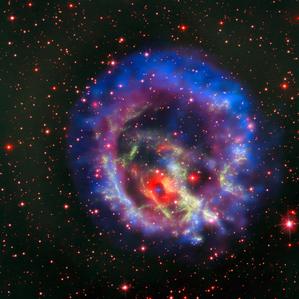Glossary term: Supernova
Description: Une supernova est une explosion stellaire énorme. Les supernovae deviennent brièvement l'objet le plus lumineux de leur galaxie avant de s'éteindre en quelques années. Deux voies principales mènent aux supernovae. La première (Type Ia) implique une naine blanche qui accrète de la matière à partir d'une étoile compagnon binaire. Une fois que la naine blanche est déstabilisée, soit en atteignant une masse supérieure à 1,4 masse solaire (connue sous le nom de limite de Chandrasekhar), soit en accumulant suffisamment d'hélium à sa surface, elle explose, sans laisser de vestige. L'autre voie principale de formation d'une supernova (Type II) est l'évolution d'une étoile de masse supérieure à 8 masses solaires. À la fin de l'évolution d'une telle étoile, elle explose, donnant naissance à une étoile à neutrons ou (pour les étoiles les plus massives) à un trou noir de masse stellaire.
Les supernovae sont la source de nombreux éléments chimiques, en particulier ceux qui sont plus lourds que le magnésium.
Related Terms:
- Binary Star
- Trou noir
- Étoile à neutrons
- Nova
- Solar Mass
- Stellar Remnants
- Naine blanche
- Gamma Ray Burst
- Chandelle standard
See this term in other languages
Term and definition status: The original definition of this term in English have been approved by a research astronomer and a teacher The translation of this term and its definition is still awaiting approval
The OAE Multilingual Glossary is a project of the IAU Office of Astronomy for Education (OAE) in collaboration with the IAU Office of Astronomy Outreach (OAO). The terms and definitions were chosen, written and reviewed by a collective effort from the OAE, the OAE Centers and Nodes, the OAE National Astronomy Education Coordinators (NAECs) and other volunteers. You can find a full list of credits here. All glossary terms and their definitions are released under a Creative Commons CC BY-4.0 license and should be credited to "IAU OAE".
Related Media
Death of a massive star
Credit: ESO/NASA, ESA and the Hubble Heritage Team (STScI/AURA)/F. Vogt et al. credit link
License: CC-BY-4.0 Creative Commons Attribution 4.0 International (CC BY 4.0) icons









